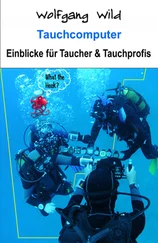
Incl. 58 illustrations
© 2014 by Wolfgang Wild. All rights reserved.
Publisher: epubli GmbH, Berlin (Germany)
www.epubli.de
ISBN: 978-3-7375-0616-8
No part of this book may be reproduced in any written, electronic, recording, or photocopying without written permission of the publisher or author. The exception would be in the case of brief quotations embodied in the critical articles or reviews and pages where permission is specifically granted by the publisher or author.
Although every precaution has been taken to verify the accuracy of the information contained herein, the author and publisher assume no responsibility for any errors or omissions. No liability is assumed for damages that may result from the use of information contained within.
Cover Design: propublishing
Cover Pic: innovasub.com, with kind permission
x
Introduction
What exactly does “conservative” mean in diving?
Dive Tables – the STUP effect
An example for reliably developed, validated and documented dive tables – the Recreational Dive Planner (RDP)
Reflections on a proper ascent rate
Excursus – How do divers control their ascent rate?
Saturation, halftime and M-value
Halftime
M-value
Doppler ultrasound and other ways to detect bubbles in our tissues
Understanding decompression sickness
”Tissue Model” vs. “Bubble Model”
Tissue Model / 1-phase model
Bubble Model / 2-phases model – Part One
The Buhlmann models ZH-L12 and ZH-L16
Gradient factors
Bubble Model / 2-phases model – Part Two
The attack on bubbles at depth
The VPM model
The RGBM model
Deep Stops – what is that?
Which stop-depth is the correct one?
What to do? STUP is for divers no real alternative!
Dive computers in practice
From table towards computer – multilevel diving
Preliminary evaluations of dive data banks – Wienke & DAN
Dive Computers 1994 – results of own practice tests
Dive Computers 2009 – practice test magazine Diver
Dive Computers 2009 – practice test magazine Scuba Diving
Practice tests in the hyperbaric chamber – Catalina Island (USA) 2011
The crux with technology
Closing chapter and perspectives
Requirements for the validation of dive computers
Dreams of the future – alternatives to the traditional dive computer
Bibliography and Internet Links
1 – Introduction
Dive Computers – Computers?
Here a selection of dive computer recalls published on the homepage of the Consumer Product Safety Commission (CPSC) which is in charge of consumer protection in the United States of America:
• AERIS Epic – decompression hazard
• Atomic Aquatics Cobalt – impact injuries and drowning hazard
• Dacor Darwin Air – serious injuries, including decompression sickness
• Hollis DG03 – drowning hazard
• Mares Nemo Air – drowning hazard
• Oceanic ATOM 2.0 – decompression hazard
• UWATEC Aladin Air X NitrOx – possible decompression sickness
Source: www.cpsc.gov
These few examples of dive computer recalls do not only concern various manufacturers, but also different mathematical calculation models (aka algorithms) and varied technical problems of our popular dive companions: A display which fails to display under water, a leaking O-ring leading to wrong remaining air times under water, a software defect which is known by the manufacturer who is forced seven years later to admit this before a United States District Court (see bibliography, San Francisco Chronicle) etc. etc. The reader will be well aware of such product recalls not being limited to diving equipment, and they are not only nerving, but actually inacceptable for us as consumers when our safety is concerned. Visiting above US government website cpsc.gov or using your favorite search engine and the proper term for “product recall” in your language reveals horrifying results. Aren’t we supposed to have fun when we go diving, and isn’t safety a prerequisite for that?
From the mechanic-pneumatic one-tissue (!) Decometer in 1959 (USA) via the legendary EDGE (USA, 1983) and Deco-Brain (Switzerland, 1983/1985) to present-day models, the dive computer has come a long way – more than half a century.
And the research which divers know as decompression theory is quite a bit older. If we take John Scott Haldane as “father” of all dive tables in 1908 this history extends well over one hundred years.
All diver training associations still regard it important that divers learn in any way why and how our body tissues are being enriched by gases which constitute the gas mixture divers breathe under water. And it is also still regarded essential for divers to get to know and manage the tools that are designed to avoid problems from this absorption of gases which always takes place in us when we use a “self-contained under water breathing apparatus” (aka “scuba”) to seek adventure and recreation in our fascinating under water realm.
Some diver training associations continue to proceed via the dive table, others have abandoned the tables completely, relying now fully on the dive computer and respective simulation programs for teaching divers the dive planning basics.
In this eBook the reader will not be pestered with lengthy mathematical equations of numerous dive computer algorithms – these can be studied in a wealth of internet articles and specialized literature that partially meets scientific requirements.
The intention of this eBook is rather to offer interested divers and diving professionals with pictures, illustrations, tables and charts deeper insights into the background and the potential of dive computers.
This will include the understanding of dive tables and some underlying specifics of the decompression models of modern dive computers.
The reader of this eBook can expect that the notorious STUP effect will be addressed – and that topics like ascent rate, ascent techniques and stop-depth are discussed is indispensable.
How does the future of dive computers look like? More gadgetry at the wrist of the diver with miniature display sizes overloaded by supposedly important information? A different path is taken by the SDC (smartphone dive computer), which leverages the enormous processing power of modern smartphones and their reasonable display sizes. This eBook also takes a look at such developments.
Finally a brief remark on the numerous sources referenced in this eBook: These are not only listed in the detailed bibliography but usually also directly in the text so that the reader is spared from frequently having to jump forward into the appendix and back into the text. And as many sources are publicly available in the internet the bibliography is providing corresponding links.
The valued reader will easily realize that the topics discussed in this eBook are addressed to all divers and diving professionals of all diver training associations.
Enjoy browsing through this eBook on your iphone, kindle, kobo, sony reader, tolino, tablet …
2 – What exactly does “conservative” mean in diving?
From the years in which divers had no alternative than using dive tables for their dive planning (because dive computers simply did not yet exist), older divers will remember the grandiose statement:
Our xyz dive table is more conservative than others.
Also dive computers and simulation programs for PC and/or tablet put forward that claim. What is suggested with such a claim or promised to divers?
Читать дальше













